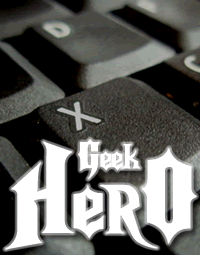 Found via The High Definite.
Found via The High Definite.
This article also appears in The Adventures of Accordion Guy in the 21st Century.
Today (Wednesday, September 22) Manning’s offering their SharePoint books, in both electronic and dead-tree form, at half price:
Just enter the promo code dotd0922 in the Promotional Code box when you check out at manning.com.
 Creative Commons photo by Sean McGrath. Click the photo to see the original.
Creative Commons photo by Sean McGrath. Click the photo to see the original.
The Fredericton .NET User Group is meeting tonight! Tonight’s presentation topic is the Open Data Protocol, as presented by Andrew Trevors of SwiftRadius.
For more about the Fredericton .NET User Group and tonight’s meeting, see my earlier posting.
 Creative Commons photo by Jason V. Click the photo to see it on its original page.
Creative Commons photo by Jason V. Click the photo to see it on its original page.
Don’t forget that this Saturday, September 25th, is the first SharePoint Saturday in Vancouver!
It’s a FREE public event, and it’s a chance for people in the Vancouver area to dive into SharePoint. It promises to be an educational, informative and lively day filled with sessions from respected SharePoint professionals and MVPs, covering a wide variety of SharePoint-oriented topics.
For more details, see my earlier blog entry on SharePoint Saturday Vancouver as well as the SharePoint Saturday Vancouver site and the registration page.
Thanks to Yaroslav Pentsarskyy for letting me know about this event!

Don’t forget that a Samedi .NET event is taking place this Saturday, September 25th in Montreal: Introduction au B.I., or as they say en Anglais, Introduction to B.I.. As in Business Intelligence. For the full details, see my earlier blog entry and the event’s registration page. It won’t cost you much to attend; admission to the event is under $10.
Thanks to La Communauté .NET Montreal for putting on the event and to Microsoft Canada Regional Director Guy Barrette, my go-to guy for keeping me in the loop on Montreal geek events!

This week, we’re having Coffee and Codes in Ottawa and Toronto! Coffee and Code is where we work out of a cafe so that we’re easy to find. Come and talk to us, ask us questions about Microsoft tools and technologies, the industry, career, whatever! We’re also here to help you deploy apps to Windows Phone 7: we’ll have a real live Windows Phone 7 device that you can deploy apps to.
Colin Melia and Rick “Claus” Claus from Microsoft’s Developer and Platform Evangelism team will be at Bridgehead Cafe (224 Dalhousie Street) from 10:00 a.m. to 4:00 p.m. to host a Coffee and Code there. Drop in, say hi, have a coffee, ask questions and if you’ve got an app, try deploying it to a real live Windows Phone 7 device!
Join Kate Gregory and me as we host a Coffee and Code at the Starbucks at King and Yonge (4 King Street West) from 11:00 a.m. to 6:00 p.m., where we’ll merge with the Coffee and iOS group who are coming in at 4:00 p.m.. Want to find out more about WP7 or iOS development? This is the time and place!
 Back in May, we held the Make Web Not War conference in Montreal, which we wrapped up with the FTW! Coding Competition. In this contest, we challenged developers to make the best possible app using a mix of both Microsoft and open source tools and tech. We offered a prize for the best overall app, with bonus prizes for use of specific technologies, and in the end, Timothy Dalby and his application, Find-A-Home, walked away with a number of them:
Back in May, we held the Make Web Not War conference in Montreal, which we wrapped up with the FTW! Coding Competition. In this contest, we challenged developers to make the best possible app using a mix of both Microsoft and open source tools and tech. We offered a prize for the best overall app, with bonus prizes for use of specific technologies, and in the end, Timothy Dalby and his application, Find-A-Home, walked away with a number of them:
I interviewed Timothy a little while back via email, asking him questions about Find-A-Home, his plans and his tech background.
Find-A-Home is basically an area research engine. You start by either directly searching an address in Edmonton, or browsing through a set of property listings. Find-A-Home will then generates a map of the area along with nearby amenities, such as schools, police stations, fire stations, parks, transit stops, and recreation centers. In addition to the map, a set of 5 metrics are also generated for the location based on proximity to amenities. These metrics essentially provide a “ranking” for each location which you can relate to what is most important to you when buying house.
I heard about the “Make Web Not War: For The Web!” (FTW!) Competition while attending an Energize I/T conference and I wanted use the open data sets being provided by the City of Edmonton in a new and useful way for my entry. I did indeed purchase a house about a year prior to coming up with the Find-A-Home concept. While mulling over a number of different ideas for the competition, it suddenly just popped into my head one day that it would have been many times easier when I bought my house if information about the area were readily available in a easy to understand way. I expanded on the concept over the following week or so and eventually came up with the vision of a metric-based “ranking” system for houses. And the rest, as they say, was history.
For the Find-A-Home project, I wanted to squeeze in as many new technologies as I possibly could in the time available. As a developer, I love learning. If I am developing and not learning something new, it is a safe bet to say that I’m bored. Windows Azure, the hosting environment for Find-A-Home, has fascinated me for as long as I knew it existed. It was something that I wanted to try out, but never had a good reason to. When the opportunity came up to build this app and have it hosted on Azure, I jumped at the idea. I also decided to use SQL Azure as the data platform.
The majority of the data behind the application is sourced from the Open Data Catalogue made available by the City of Edmonton.
The core development technology behind Find-A-home was initially C/ASP.NET 4.0 and the brand-new ASP.NET MVC 2 framework. Later in the development, I discovered that Windows Azure (at the time) only supported up to .NET 3.5. As a result, I had to downgrade the project to ASP.NET 2.0, but I still used the MVC 2 framework. The mapping functionality I decided on was Bing maps. I really wanted to fit PHP into the mix somehow, but I ran out of time before I had a chance to do so.
(One other really nice benefit to using a variety of technologies was that it made my project eligible for 3 out of the 5 bonus categories in the competition.)
Since winning the “FTW!” competition, I have spent a lot of time researching commercial viability of the project. Ultimately, I would like to expand greatly on the feature sets and would like to see it being used by everyone in Canada when they look to buy a new home as the definitive property research guide.
I should start by saying that I have been programming since grade 7. I learned my first “Hello World” application using BASIC on the Apple IIe systems at my school and I was instantly hooked. I started getting those “Learn to code a game in only 1kb!” books from the local library and taught myself some basic programming skills. Then my family got a 80286 PC and I graduated my programming to QuickBASIC 4.5 on MS-DOS. I remember spending an entire summer one year in junior high working on a text-based adventure game called “Haunted House.” It was my first major software undertaking and the start of what would eventually become a dearly-loved career.
In Grade 9 (mid-late 1990s), I started to hear about this thing called the Internet and eventually got myself a GeoCities account and taught myself HTML and JavaScript programming. From there, I branched into various web technologies, including asp and some basic cgi perl code. After graduating from high school, I attended the two year Computer Systems Technology diploma program at the Northern Alberta Institute of Technology (NAIT) to finally solidify all of this programming knowledge I had accumulated since childhood into something useful for the business world.
I had the unfortunate luck of graduating from NAIT (in 2003) at what was one of the worst possible times for the IT industry in Edmonton. There were no programming jobs available, so I started off working for a call center, like many IT people in Edmonton. Eventually, I got a job at the Dell Edmonton call center where I was able to work my way into a position that had me developing internal web applications in C#/ASP.NET on a full-time basis. I have spent the last two and a half years working at a great company called Investopedia in full-time web development. The primary programming languages/technologies I am fluent in are C#, VB, XML, HTML/CSS/Javascript/jQuery, ASP, Python, MS SQL, and MySql. I also have a decent level of experience with network architecture and security.
As a hobbyist, I have developed a bit of an addiction to hardware and programming competitions. I have participated in the last two years of the Microsoft Embedded Spark competition, in which I learned hardware development and programming using Windows CE 6.0 and managed to make it through to Round 2 on both years. My first hardware project was a web connected, portable insurance cataloging and price finding system. The second project was a brain-controlled Dunk Tank, where you would wear a headband that read your brain waves in an attempt to center a ball on a target on a computer monitor. If aimed successfully, the computer would fire the release for the dunk tank’s platform. I also worked with my good friend, Mike, on a project that had us hacking the brand new Nokia N900 cell phone. We managed to win the “PUSH N900” competition (along with 4 other great teams) by designing and building a belt (called the Haptic Guide) that can guide you to the location of a geo-coded photo using only haptic (touch) feedback through a collection of vibrational motors embedded into the belt.
My latest competition was the “FTW!” competition, for which the Find-A-Home project was developed. I decided to take this summer off from competitions, but I hope to resume competing for the winter Embedded Spark competition.